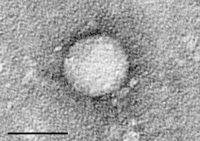
Photo from wikipedia
This study aimed to compare the effects of laparoscopic repeat liver resection (LRLR) and open repeat liver resection (ORLR) on surgical site wound infection and pain in recurrent hepatocellular carcinoma.… Click to show full abstract
This study aimed to compare the effects of laparoscopic repeat liver resection (LRLR) and open repeat liver resection (ORLR) on surgical site wound infection and pain in recurrent hepatocellular carcinoma. PubMed, EMBASE, Cochrane Library, China National Knowledge Infrastructure, and Wanfang Data were systematically searched for studies comparing LRLR with ORLR for the treatment of recurrent hepatocellular carcinoma, with a search timeframe from their inception to December 2022. Two investigators independently screened the literature, extracted information, and evaluated the quality of the studies according to the inclusion and exclusion criteria. This study was performed using RevMan 5.4 software. A total of 20 publications with 4380 patients were included, with 1108 and 3289 patients in the LRLR and ORLR groups, respectively. The results showed that LRLR significantly reduced surgical site wound infection rate (1.71% vs. 5.16%, odds ratio [OR]:0.32, 95% confidence interval [CI]: 0.18-0.56, P < .001), superficial wound infection rate (1.29% vs. 4.92%, OR: 0.29, 95% CI: 0.14-0.58, P < .001), bile leakage (3.34% vs. 6.05%, OR: 0.59, 95% CI: 0.39-0.90, P = .01), organ/space wound infection rate (0.4% vs. 5.11%, OR: 0.23, 95% CI: 0.07-0.81, P = .02), and surgical site wound pain (mean difference: -2.00, 95% CI: -2.99 to -1.02, P < .001). Thus, the findings of this study showed that LRLR for recurrent hepatocellular carcinoma significantly reduced wound infection rates and improved postoperative wound pain.
Journal Title: International wound journal
Year Published: 2023
Link to full text (if available)
Share on Social Media: Sign Up to like & get
recommendations!